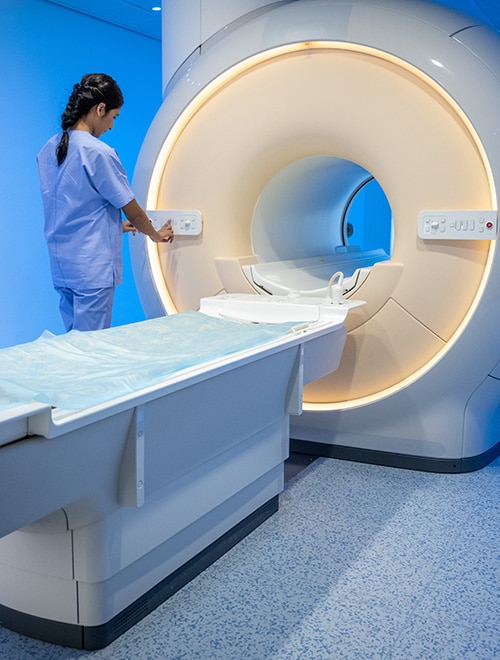- 4 min read
Diagnosing prostate cancer with a biopsy
Diagnosing or ruling out prostate cancer can be a complicated process involving many tests and scans.
A biopsy is the only way to know for sure if you have prostate cancer.
If your symptoms, risk factors or previous tests show that you might have prostate cancer then a biopsy may be the next step. A biopsy is used to diagnose as well as grade your cancer, which means that it can tell the urologist how fast your cancer is growing.
Before a biopsy you will have had one or more of the following:
Ask your doctor lots of questions about the biopsy so you feel comfortable and prepared.
From these results your urologist may recommend that you have a biopsy, as it is the only way to definitively diagnose prostate cancer. This procedure is always done with some form of anaesthetic and may include sedative medications. Your urologist will take steps to minimise any discomfort, but it is a surgical procedure, so please make sure you ask your urologist as many questions as you need before going ahead with a biopsy.
What is a biopsy and what does it involve?
A prostate biopsy is a surgical procedure where a urologist (surgeon) will use a special needle (biopsy needle) to remove multiple small samples of tissue from your prostate gland.
There are two different ways a biopsy can be performed:
- Transperineal biopsy – this involves passing a biopsy needle through your perineum (the skin between your scrotum and your anus). More than 70% of biopsies are done this way in Australia.
- Transrectal ultrasound biopsy – this involves passing a biopsy needle through your rectum.
The transperineal biopsy is done in hospital and you will be given an anaesthetic. A lubricated ultrasound probe will be gently inserted into your rectum to provide an image of your prostate and guide your urologist while they take the tissue samples. Several samples will be collected by passing the biopsy needle through your perineum and into your prostate.
The transrectal biopsy can be done in your urologist’s consulting room or in hospital. They will use a local anaesthetic to numb your prostate. You may also have some sedative medications to make you more comfortable. As for the transperineal biopsy, ultrasound will be used to provide an image of your prostate and guide your urologist as they take the samples.
Does a biopsy have any side effects?
Before having a biopsy, make sure you tell your urologist about any medications or supplements you are taking, especially blood-thinning medications
There is a small chance you may have pain and bruising after a biopsy. It is also very common to see some blood in your urine or semen after this procedure. Generally, any side-effects only last a short time and are manageable. Infection rates after a biopsy are low, but if you have any concerning symptoms, such as a fever or difficulty passing urine, seek medical advice immediately.
What happens with the biopsy samples?
The samples are sent to a pathologist to be examined. They will look at your samples under a microscope to determine if there are any cancer cells present. If there are cancer cells, they will determine the grade of the cancer. The cancer grade provides information on how aggressive the cancer is – how fast it is growing and how likely it is to spread. Your urologist will discuss the pathology report and next steps with you.
Biopsy results – what do they mean?
What happens next depends on your biopsy results.
If your biopsy is negative for prostate cancer, then your urologist may recommend that you have regular PSA testing to monitor your prostate. If your PSA levels rise again, you may need another biopsy or an MRI scan.
A negative biopsy may mean regular PSA tests, a low-risk biopsy result may mean active surveillance and a positive biopsy may mean treatment.
If your biopsy result, your individual risk factors and the results of any other tests you may have had suggest that your prostate cancer is low risk, you may be offered active surveillance. This involves regular testing and monitoring of your cancer, with treatment offered if the cancer becomes more of a risk to your health.
If your biopsy shows you have medium or high-risk cancer your urologist will talk to you about the results and what treatment options are suitable for you. You may be required to have further tests to determine the stage of the cancer. The cancer stage tells your doctor whether the cancer has stayed within the prostate gland or has spread outside of the prostate to surrounding areas or other parts of the body.
This can be a very stressful process, especially if the biopsy result is positive for prostate cancer. It’s a good idea to take your partner, family member or a friend with you when you visit your urologist. It can also help to write down any questions you would like your urologist to answer during your appointment. If you need any advice or information, you can also contact a PCFA nurse.
Key points
- Biopsy is the only way to definitively diagnose prostate cancer
- It involves taking small samples of your prostate tissue
- Biopsies are performed with anaesthetic and may include sedative medications
- There are two types of biopsies: transperineal (done in hospital) and transrectal (done in consulting room or hospital)
- A pathologist will report on whether cancer cells are present and if the cancer is fast or slow growing
- Your urologist will discuss with you the options for more testing or treatment, based upon all your results and personal circumstances






